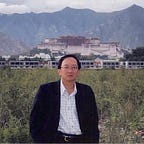Biden and the G7 Have a Dream…… to challenge the BRI with the B3W
China has embarked on the Belt and Road Initiative BRI since 2013. It was first mooted by President Xi Jinping that year as a major infrastructure drive that will stretch from East Asia to Europe, that will significantly expands China’s economic and political influence. As of mid-2020, more than 100 countries are project-participants of China’s BRI, in more than 2600 projects, with a total value of US$3.7 trillion. These include rail links, roads, harbours, oil pipelines, hydroelectric power stations, etc
Many of the overseas strategic projects are undertaken by Chinese-owned infrastructure firms, who are world-leading players because of their home track records, having worked successfully on similar projects. As BRI projects are mainly 3rd-world projects, external financing is necessary. So Chinese-financing for the partner countries are common, usually through low-interest loans by Chinese financial institutions. The BRI loans re-payments by the partner countries will expectedly then find their way back into China.
BRI projects are aimed at improving connectivity and shared prosperity, under the concept of a ‘modern silk route’ linking China to Central Asia and beyond. The living standards of the locals in these countries that join the BRI are improved because of the better infrastructure and they will become financially better off. This will translate to a higher demand for goods and products as wealth leads to higher domestic consumption, meaning the country will import more goods. Where does these goods come from? China of course!
This will end up making many Chinese companies richer. A win-win situation for China and the BRI partners. Goodwill will be generated in the process, contributing to the enhanced friendship and future well-being of all.
The West has not failed to notice this development and perceives BRI as a looming threat. From the beginning, they worry that it could be a Trojan horse to hide China-led regional development and military expansion. At the end of the recent G7 Summit, the G7 group announced the plans for a new infrastructure plan called B3W, to counter BRI. According to Biden, B3W would be “much more equitable” and transparent than China’s Belt and Road Initiative. Details are largely sketchy and unavailable, so for now, it is nothing more than a bold proclamation of intent, targeting the BRI as its key motivating rival.
Because the US and the G7 partners do not have the kind of infrastructure builders China has, who can build better and cheaper, we can expect the project costs will be much much higher. If they put up international tenders, China companies will out-compete all other suppliers and win.
If and when the B3W projects are completed, the locals will benefit and we expect wealth will be created for these locals. Wealth will give rise to greater local demand for goods and products, and the same cycle as BRI ensues. There will be more Chinese products import, resulting in a boosting of the Chinese economy, further enriching the Chinese, thanks to Biden and his B3W plans!
So Biden’s intent of building a better world through B3W means building a better, richer China!
To challenge China in the infrastructure arena is a mission doomed. Just imagine this, US weakness pitted against China’s strength – that spells certain disaster.
China is not known as the ‘Infrastructure-building Monster’ for nothing. The term describing them <基建狂魔*> is a well-earned one and China has many proud monumental achievements to testify to the title.
China hones its skills in infrastructure-building over years of working on critical and massive domestic projects. Along the way, they have develop new technologies and equipments to help them deliver better and safer projects faster, so much so they are leading the world in many technical areas, like high-speed rail, 5G, bridge-building that spans mountains and raging rivers, tunnelling machinery, etc. These assets are what China is drawing upon now, to implement BRI overseas. Many of the skill-sets are what the west desperately needs, in trying to play catch-up with China.
In a Twitter wrap of his week-long transatlantic jaunt to UK, Brussels and Geneva, Biden gushed :
“ After a busy week, it’s clear America is back again, our alliances are stronger than ever, and we’re ready to tackle the toughest global challenges of our times alongside our allies “
Making bold phrases like America is Back sounds cool, but in actual fact he sounds unbelievable and rather pitiful, basking in the sham of insisting American is once again leading the world. The mountains of endemic American problems inside the country are still around and remain unsolvable. These include racial discrimination, hate crimes, political disunity, immigration headaches, human rights abuse, plights of the poor and homeless, aging infrastructure, the ongoing pandemic, etc. They are engulfing and choking America. Biden needs to tackle these much more than he needs to go and try to lead the world. The words sounds empty and meaningless, except to sooth the ego of a weak octogenarian who thinks he is a saviour that will be leading America’s rise again.
Paste this against the backdrop that Biden has only 3 years or more to go, before he faces the next presidential election challenge, he may find all his efforts totally up-ended before anything can be achieved!
It’s a pitiful scenario, but The Age of America dictating the world is truly gone, never to return. We will see the dawn of a different world with a new world order soon enough.
* Added translation
基建狂魔 : Infrastructure-building Monster
It’s a term the Chinese proudly name themselves, describing the fervour and speed at which China takes on huge infrastructure projects at home, overcome all problems, develop new technologies to make themselves the King of infrastructure today.
++++++++++++++++++++
